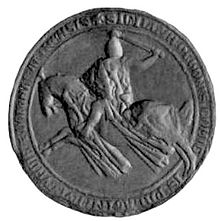Otto IV, Count of Burgundy
| Otto IV | |
|---|---|
 Seal of Otto IV | |
| Count of Burgundy | |
| Reign | 8 March 1279 – 17 March 1303 |
| Predecessor | Adelaide |
| Successor | Joan II |
| Born | c. 1248 Ornans |
| Died | 17 March 1303 Melun |
| Spouse | Philippa of Bar Mahaut of Artois |
| Issue | Joan II, Countess of Burgundy Blanche, Queen of France Robert of Burgundy |
| House | House of Ivrea |
| Father | Hugh de Châlon |
| Mother | Adelaide, Countess Palatine of Burgundy |
Otto IV (c. 1248, in Ornans – 17 March 1303, in Melun[1]) was the count of the Free County of Burgundy from 1279 until 1303.
Life
Otto was the son of Hugh of Châlons and Adelaide, Countess Palatine of Burgundy.[2] Upon his father's death in 1266/7, he became Count of Châlons. In 1267, the pro-French Otto IV got in conflict with his half-uncle John I of Chalon-Arlay, who was supported by his vassals.[3] His mother, Adelaide, died on 8 March 1279, and Otto inherited her county. However, he was unable to secure real power in the county until 1295.[4] His elder daughter Joan II succeeded in the County of Burgundy, which was later given as dowry on her marriage to Philip.[5]
His wife Mahaut drew up a contract on 4 June 1312 with the famous tomb maker Jean Pepin de Huy to make a tomb.[6] The contract specifies a tomb made of stone and alabaster.[6] Otto was to be shown as an armed knight with a shield, sword and armor.[6] A lion was shown beneath his feet with two angels to support the pillow under his head.[6] The tomb no longer exists, but the designs have been preserved.
Marriage and children
Otto married Philippa of Bar in 1271. The marriage was childless.[7]
In 1285, Otto married his second wife, Mahaut, Countess of Artois.[7] They had:
- Joan II, Countess of Burgundy (c.1291 - 1330) married Philip, Count of Poitiers (later King of France) in 1307[8]
- Blanche (c.1296 - 1326) married Charles, Count of La Marche (also later King of France).[8]
- Robert (c.1300 – 1317).
References
- ^ Gauthier 1903, p. 61.
- ^ Jackson-Laufer 1999, p. 19.
- ^ "Chalon". Encarta Encyclopedie Winkler Prins (in Dutch). Microsoft Corporation/Het Spectrum. 2002.
- ^ Cox 1999, p. 363-365.
- ^ Funck-Brentano 1888, p. 16.
- ^ a b c d Frisch 1987, p. 113.
- ^ a b Cox 1974, p. 463.
- ^ a b Brown 2009, p. 223.
Sources
- Brown, Elizabeth A.R. (2009). "Blanche of Artois and Burgundy, Chateau-Gaillard, and the Baron de Joursanvault". In Smith, Katherine Allen; Wells, Scott (eds.). Negotiating community and difference in medieval Europe: gender, power, patronage, and the authority of religion in Latin Christendom. BRILL.
- Cox, Eugene L. (1974). The Eagles of Savoy. Princeton: Princeton University Press. ISBN 0691052166.
- Cox, Eugene (1999). "The kingdom of Burgundy, the lands of the house of Savoy and adjacent territories". In Abulafia, David (ed.). The New Cambridge Medieval History: Volume 5, C.1198-c.1300. Cambridge University Press.
- Frisch, Teresa G. (1987). Gothic Art 1140-c. 1450:Sources and Documents. University of Toronto Press.
- Funck-Brentano, Frantz (1888). "Philippe le Bel et la Noblesse Franc-Comtoise". Bibliothèque de l'École des chartes. 49. Librairie Droz: 5–40.
- Gauthier, M. Jules (1903). "Services Funebres du Comte Othon IV de Bourgogne celebres en Franche-Comte en 1303". Bulletin Historique et Philologique. Imprimerie Nationale.
- Jackson-Laufer, Guida Myrl (1999). Women Rulers Throughout the Ages: An Illustrated Guide. ABC-CLIO.
